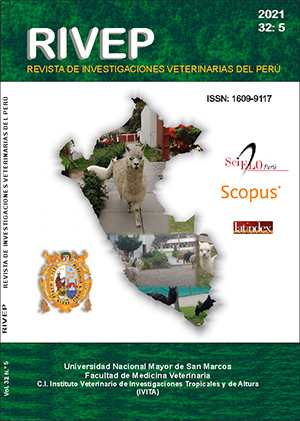Comparison of ovulation inducers in an FTAI programme with sexed semen in Bos taurus x Bos indicus heifers
DOI:
https://doi.org/10.15381/rivep.v32i5.19823Keywords:
bovine, FTAI, pregnancy rate, follicular dynamicAbstract
The aim of this study was to compare the efficiency of estradiol cypionate (ECP) and estradiol benzoate (EB) as ovulation inducers in a fixed-time artificial insemination program (FTAI) using sexed semen in Senepol x Brahman red heifers. All animals received on day 0 an intravaginal device of progesterone (P4) of 0.5 g for eight days + 2 mg BE. Heifers in group 1 (n=177) received 150 μg PGF2α + 150 IU eCG + 1 mg CPE and heifers in group 2 (n=177) 150 IU eCG + 150 μg PGF2α and 24 h later received 1 mg BE. Heifers were inseminated with sexed semen 60 h after removal of the P4 device. The diameter of the preovulatory follicle and the gestation rates were determined by type of ovulation inducer. The diameter of the preovulatory follicle in heifers treated with ECP (11.48 ± 2.88 mm) was statistically similar to those treated with BE (10.81 ± 2.08 mm). A higher gestation rate (p=0.0069) was found in the ECP group (51.4%) than in the BE group (38.4%). It is concluded that CEP in comparison with BE as an ovulation inducer in IATF protocols favors pre-ovulatory follicle growth and gestation rates.
Downloads
Downloads
Published
Issue
Section
License
Copyright (c) 2021 Diana Carolina Toro García, Diego Armando Vega Borda, Héctor Javier Narváez, Deicy Villalba Rey, Daniela Alvarado

This work is licensed under a Creative Commons Attribution 4.0 International License.
AUTHORS RETAIN THEIR RIGHTS:
a. Authors retain their trade mark rights and patent, and also on any process or procedure described in the article.
b. Authors retain their right to share, copy, distribute, perform and publicly communicate their article (eg, to place their article in an institutional repository or publish it in a book), with an acknowledgment of its initial publication in the Revista de Investigaciones Veterinarias del Perú (RIVEP).
c. Authors retain theirs right to make a subsequent publication of their work, to use the article or any part thereof (eg a compilation of his papers, lecture notes, thesis, or a book), always indicating the source of publication (the originator of the work, journal, volume, number and date).



